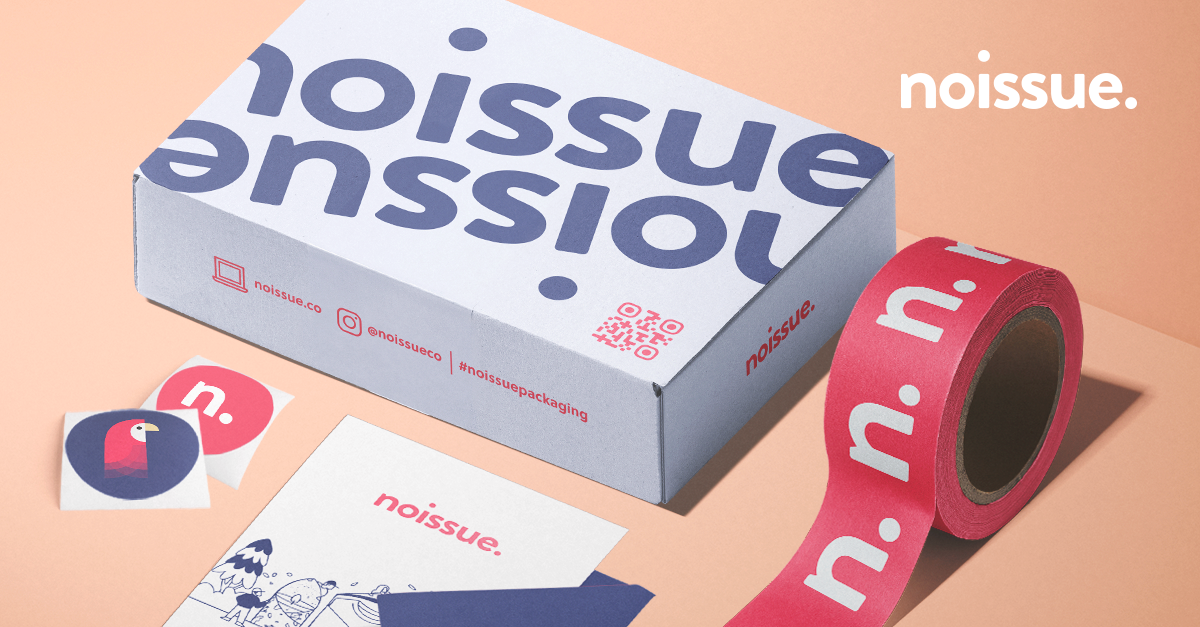In 2016, a New Zealand start-up noissue spotted a significant gap in the packaging industry. While operating their eco-friendly eyewear brand, founders Josh Bowden and Augie Gruar found that sustainable packaging options were scarce and generally difficult to access as a small business. Traditional packaging providers typically required large minimum orders, making it tough to access any affordable, customised solutions let alone sustainable ones.
Recognising that many small businesses shared this challenge, Bowden and Gruar launched noissue with a simple yet groundbreaking idea: a platform enabling businesses to design and order customisable, sustainable packaging in small quantities.
The response was overwhelming. By catering to an unmet need, noissue quickly gained traction.
By 2022, the company had attracted over 80,000 customers worldwide, secured a $10 million Series A funding round, and expanded its team to 130 people across seven countries.

noissue’s rapid growth and market leadership illustrate a classic Blue Ocean Strategy. By creating a new market space and offering unique value, noissue rendered traditional competition irrelevant and established a thriving niche.
Why It Worked
noissue’s success stemmed from addressing the unmet needs of small to medium enterprises (SMEs) for beautiful and sustainable packaging without the barrier of high minimum order quantities (MOQs). Their digital-first approach using an online platform simplified customisation and ordering, making sustainable packaging accessible and affordable.
Key elements of their success included:
Addressing a Market Gap
By allowing orders in small quantities, noissue met the specific needs of SMEs for personalised packaging, a service often unavailable from larger suppliers
Accessibility and Affordability
Unlike traditional packaging processes that involve complex ordering processes and high minimum orders, noissue’s digital-first approach streamlined customisation and ordering, making it more accessible and affordable
Alignment with Consumer Trends
Demand for eco-friendly products was on the rise. noissue capitalised on this trend, distinguishing itself from conventional suppliers by offering sustainable materials.
noissue carved out a new market space, effectively distinguishing itself from traditional packaging suppliers, and swiftly became a dominant player in the SME market.
Other Examples of Blue Ocean in Practice
Southwest Airlines
Before Southwest’s entry, the airline industry was largely dominated by major carriers that concentrated on long-haul flights. This operational model was characterised by high costs and complex logistical arrangements, with limited differentiation between providers. Short-haul travel was predominantly served by alternative modes of transportation, such as cars and buses.
Southwest airlines applied a blue ocean strategy by focusing on:
Targeting a Market Gap
Southwest focused on short-haul, point-to-point flights, addressing the underserved segment of budget-conscious traveler’s who previously relied on land-based travel.
Cost Efficiency
By eliminating complex hub-and-spoke systems and offering a no-frills experience, Southwest significantly reduced operational costs. This allowed them to provide attractive fares while maintaining profitability.
Distinctive Service
The airline implemented a friendly, no-frills service model, distinguishing itself from competitors and appealing to traveler’s seeking straightforward, affordable options.
Southwest’s strategy created a new market space where low-cost travel became the norm for short-haul routes. This approach allowed them to attract price-sensitive travellers who were previously underserved by traditional carriers
Xero
Before Xero, accounting software was primarily designed for large enterprises and was often complex, expensive, and difficult to use. Small and medium-sized enterprises (SMEs) had limited access to affordable and user-friendly accounting solutions.
Xero implemented a blue ocean strategy by focusing on:
Targeting a Market Gap
Unlike competitors who provided complex and costly software for large enterprises, Xero focused on the needs of SMEs, offering a solution tailored to their requirements.
Accessibility and Affordability
By providing a cloud-based solution with a subscription pricing model, Xero eliminated high upfront costs, making it easier and more affordable for SMEs to adopt modern accounting practices.
User-Friendly Design
Xero created an online accounting platform with an intuitive interface, simplifying bookkeeping and financial management for users.
Xero’s focus on SMEs established a new market space in the accounting software industry. This approach has led to remarkable success, with an annualized monthly recurring revenue of $1.7 billion in 2024.
Key Takeaways
Identify Unmet Needs
Look for areas where existing solutions fall short of meeting customer needs or where there is dissatisfaction with current offerings.
Target Underserved Segments
Find and serve customer segments that are underserved or overlooked by existing market players. Tailor your offerings to their specific needs and preferences.
Simplify and Innovate
Simplify the product or service experience to make it more accessible. Innovation should focus on removing complexity and enhancing user experience.
Potential Risks
Market Misjudgment
Misidentifying market needs or overestimating demand can lead to unsuccessful product launches.
Competitive Response
Existing competitors may quickly adapt and introduce similar solutions, increasing competition in the new market space.
Ready to Dive Deeper?
Discover how to effectively apply blue ocean strategy with our how-to guide: Blue Ocean Strategy
Explore other strategic tools designed for consultants and change-makers here
Stay updated with the latest case studies and strategic insights—subscribe to our newsletter